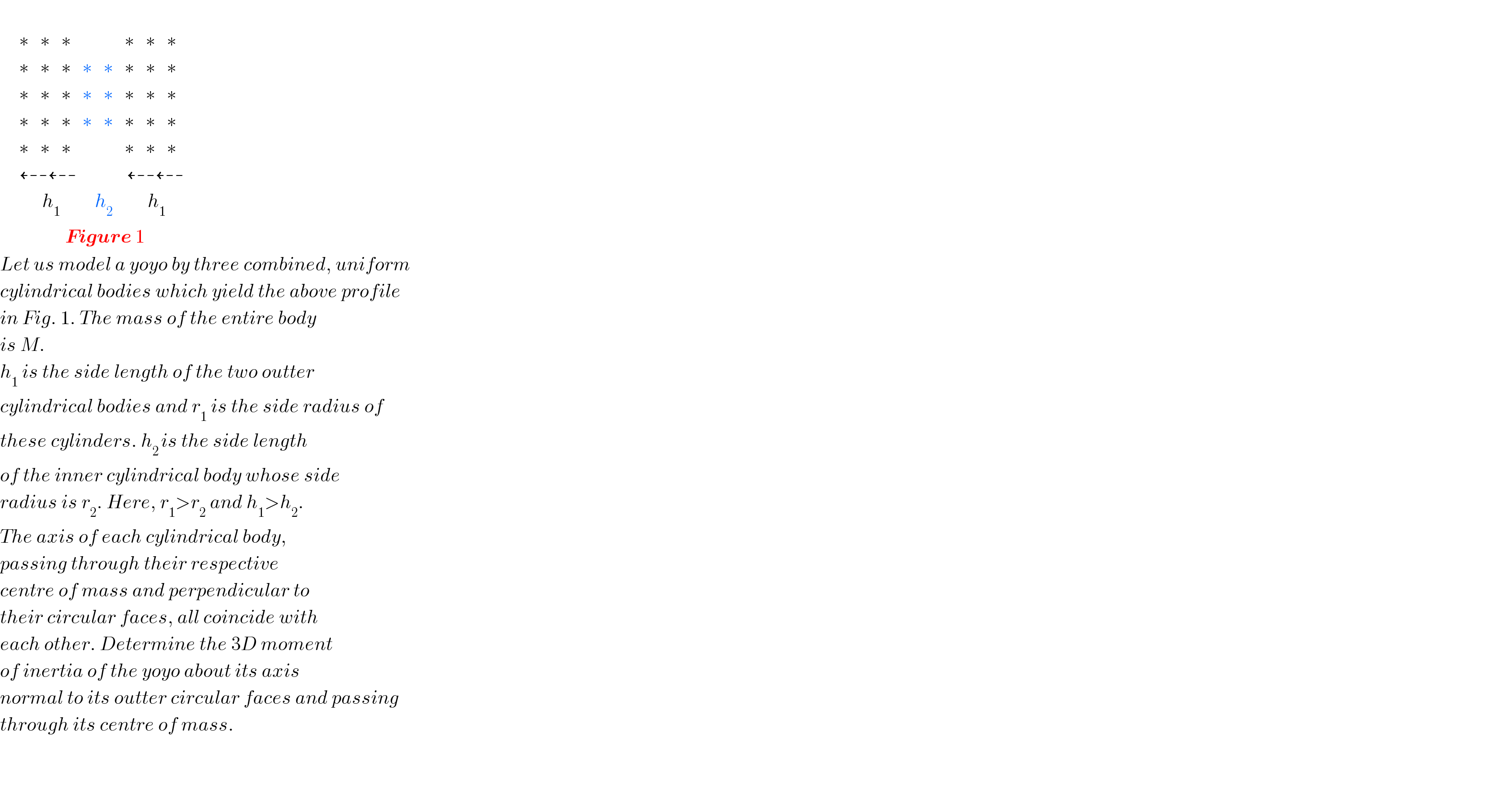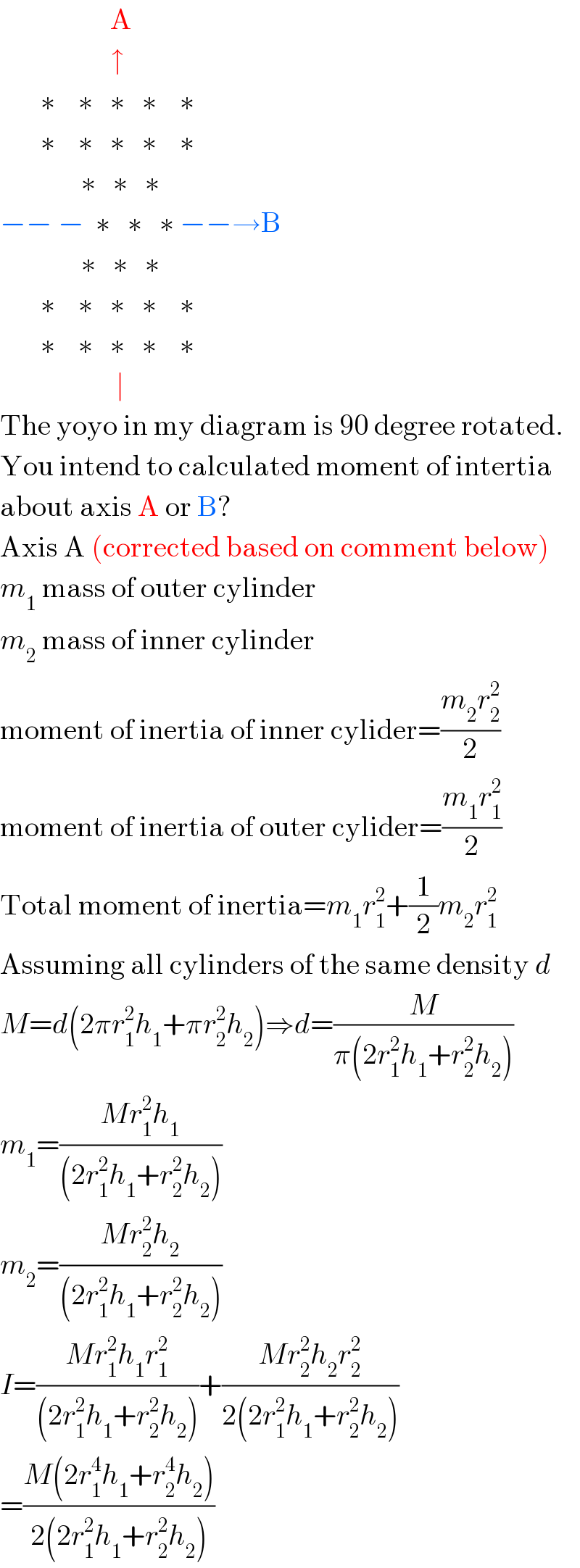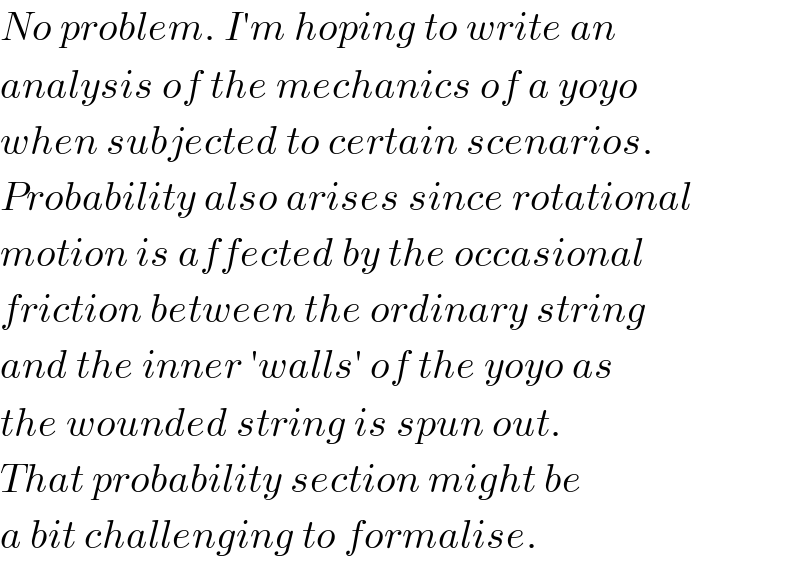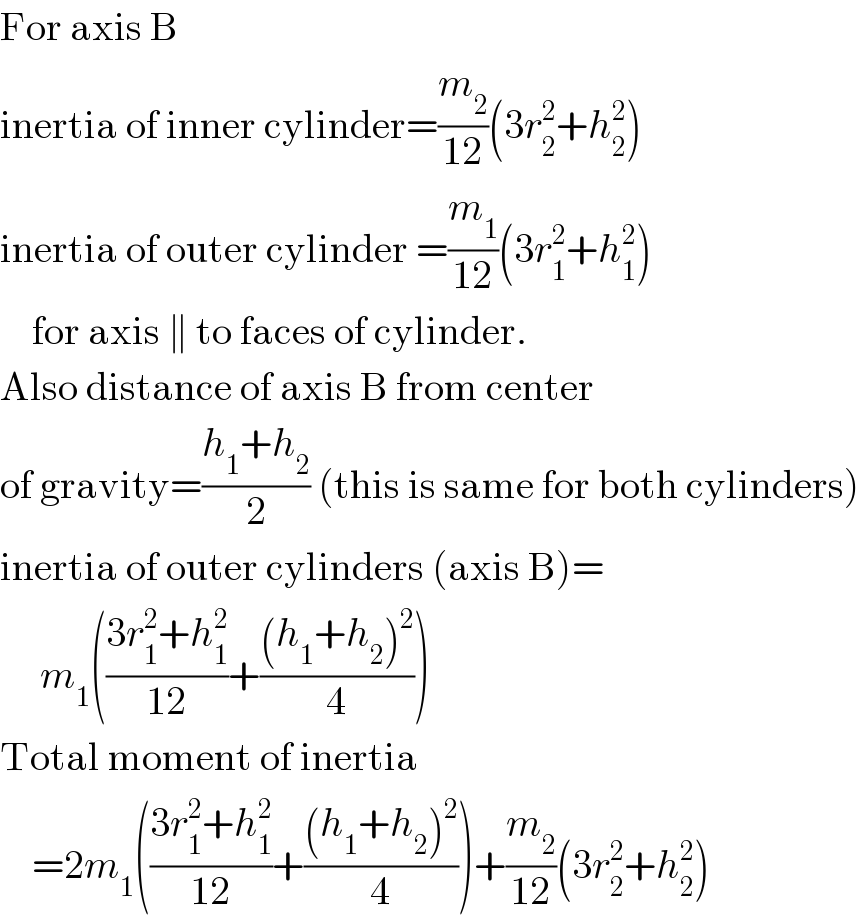
Question Number 3337 by Yozzi last updated on 11/Dec/15

$$\:\: \\ $$$$\:\:\:\:\:\ast\:\:\:\ast\:\:\:\ast\:\:\:\:\:\:\:\:\:\:\:\:\:\:\ast\:\:\:\ast\:\:\:\ast \\ $$$$\:\:\:\:\:\ast\:\:\:\ast\:\:\:\ast\:\:\:\ast\:\:\:\ast\:\:\:\ast\:\:\:\ast\:\:\:\ast \\ $$$$\:\:\:\:\:\ast\:\:\:\ast\:\:\:\ast\:\:\:\ast\:\:\:\ast\:\:\:\ast\:\:\:\ast\:\:\:\ast \\ $$$$\:\:\:\:\:\ast\:\:\:\ast\:\:\:\ast\:\:\:\ast\:\:\:\ast\:\:\:\ast\:\:\:\ast\:\:\:\ast \\ $$$$\:\:\:\:\:\ast\:\:\:\ast\:\:\:\ast\:\:\:\:\:\:\:\:\:\:\:\:\:\:\ast\:\:\:\ast\:\:\:\ast \\ $$$$\:\:\:\:\:\dashleftarrow\dashleftarrow\:\:\:\:\:\:\:\:\:\:\:\:\:\dashleftarrow\dashleftarrow \\ $$$$\:\:\:\:\:\:\:\:\:\:\:{h}_{\mathrm{1}} \:\:\:\:\:\:\:\:\:{h}_{\mathrm{2}} \:\:\:\:\:\:\:\:\:{h}_{\mathrm{1}} \\ $$$$\:\:\:\:\:\:\:\:\:\:\:\:\:\:\:\:\:\boldsymbol{{Figure}}\:\mathrm{1} \\ $$$${Let}\:{us}\:{model}\:{a}\:{yoyo}\:{by}\:{three}\:{combined},\:{uniform} \\ $$$${cylindrical}\:{bodies}\:{which}\:{yield}\:{the}\:{above}\:{profile} \\ $$$${in}\:{Fig}.\:\mathrm{1}.\:{The}\:{mass}\:{of}\:{the}\:{entire}\:{body} \\ $$$${is}\:{M}. \\ $$$${h}_{\mathrm{1}} \:{is}\:{the}\:{side}\:{length}\:{of}\:{the}\:{two}\:{outter} \\ $$$${cylindrical}\:{bodies}\:{and}\:{r}_{\mathrm{1}} \:{is}\:{the}\:{side}\:{radius}\:{of}\: \\ $$$${these}\:{cylinders}.\:{h}_{\mathrm{2}\:} {is}\:{the}\:{side}\:{length} \\ $$$${of}\:{the}\:{inner}\:{cylindrical}\:{body}\:{whose}\:{side} \\ $$$${radius}\:{is}\:{r}_{\mathrm{2}} .\:{Here},\:{r}_{\mathrm{1}} >{r}_{\mathrm{2}} \:{and}\:{h}_{\mathrm{1}} >{h}_{\mathrm{2}} . \\ $$$${The}\:{axis}\:{of}\:{each}\:{cylindrical}\:{body}, \\ $$$${passing}\:{through}\:{their}\:{respective} \\ $$$${centre}\:{of}\:{mass}\:{and}\:{perpendicular}\:{to} \\ $$$${their}\:{circular}\:{faces},\:{all}\:{coincide}\:{with} \\ $$$${each}\:{other}.\:{Determine}\:{the}\:\mathrm{3}{D}\:{moment} \\ $$$${of}\:{inertia}\:{of}\:{the}\:{yoyo}\:{about}\:{its}\:{axis} \\ $$$${normal}\:{to}\:{its}\:{outter}\:{circular}\:{faces}\:{and}\:{passing} \\ $$$${through}\:{its}\:{centre}\:{of}\:{mass}. \\ $$$$ \\ $$$$ \\ $$
Commented by prakash jain last updated on 11/Dec/15

$$\:\:\:\:\:\:\:\:\:\:\:\:\:\:\:\:\:\:\:\mathrm{A} \\ $$$$\:\:\:\:\:\:\:\:\:\:\:\:\:\:\:\:\:\:\:\uparrow \\ $$$$\:\:\:\:\:\:\:\ast\:\:\:\:\ast\:\:\:\ast\:\:\:\ast\:\:\:\:\ast \\ $$$$\:\:\:\:\:\:\:\ast\:\:\:\:\ast\:\:\:\ast\:\:\:\ast\:\:\:\:\ast \\ $$$$\:\:\:\:\:\:\:\:\:\:\:\:\:\:\ast\:\:\:\ast\:\:\:\ast\:\:\:\: \\ $$$$−−\:−\:\:\ast\:\:\:\ast\:\:\:\ast\:−−\rightarrow\mathrm{B}\:\:\: \\ $$$$\:\:\:\:\:\:\:\:\:\:\:\:\:\:\ast\:\:\:\ast\:\:\:\ast\:\:\:\: \\ $$$$\:\:\:\:\:\:\:\ast\:\:\:\:\ast\:\:\:\ast\:\:\:\ast\:\:\:\:\ast \\ $$$$\:\:\:\:\:\:\:\ast\:\:\:\:\ast\:\:\:\ast\:\:\:\ast\:\:\:\:\ast \\ $$$$\:\:\:\:\:\:\:\:\:\:\:\:\:\:\:\:\:\:\:\:\mid \\ $$$$\mathrm{The}\:\mathrm{yoyo}\:\mathrm{in}\:\mathrm{my}\:\mathrm{diagram}\:\mathrm{is}\:\mathrm{90}\:\mathrm{degree}\:\mathrm{rotated}. \\ $$$$\mathrm{You}\:\mathrm{intend}\:\mathrm{to}\:\mathrm{calculated}\:\mathrm{moment}\:\mathrm{of}\:\mathrm{intertia} \\ $$$$\mathrm{about}\:\mathrm{axis}\:\mathrm{A}\:\mathrm{or}\:\mathrm{B}? \\ $$$$\mathrm{Axis}\:\mathrm{A}\:\left(\mathrm{corrected}\:\mathrm{based}\:\mathrm{on}\:\mathrm{comment}\:\mathrm{below}\right) \\ $$$${m}_{\mathrm{1}} \:\mathrm{mass}\:\mathrm{of}\:\mathrm{outer}\:\mathrm{cylinder} \\ $$$${m}_{\mathrm{2}} \:\mathrm{mass}\:\mathrm{of}\:\mathrm{inner}\:\mathrm{cylinder} \\ $$$$\mathrm{moment}\:\mathrm{of}\:\mathrm{inertia}\:\mathrm{of}\:\mathrm{inner}\:\mathrm{cylider}=\frac{{m}_{\mathrm{2}} {r}_{\mathrm{2}} ^{\mathrm{2}} }{\mathrm{2}} \\ $$$$\mathrm{moment}\:\mathrm{of}\:\mathrm{inertia}\:\mathrm{of}\:\mathrm{outer}\:\mathrm{cylider}=\frac{{m}_{\mathrm{1}} {r}_{\mathrm{1}} ^{\mathrm{2}} }{\mathrm{2}} \\ $$$$\mathrm{Total}\:\mathrm{moment}\:\mathrm{of}\:\mathrm{inertia}={m}_{\mathrm{1}} {r}_{\mathrm{1}} ^{\mathrm{2}} +\frac{\mathrm{1}}{\mathrm{2}}{m}_{\mathrm{2}} {r}_{\mathrm{1}} ^{\mathrm{2}} \\ $$$$\mathrm{Assuming}\:\mathrm{all}\:\mathrm{cylinders}\:\mathrm{of}\:\mathrm{the}\:\mathrm{same}\:\mathrm{density}\:{d} \\ $$$${M}={d}\left(\mathrm{2}\pi{r}_{\mathrm{1}} ^{\mathrm{2}} {h}_{\mathrm{1}} +\pi{r}_{\mathrm{2}} ^{\mathrm{2}} {h}_{\mathrm{2}} \right)\Rightarrow{d}=\frac{{M}}{\pi\left(\mathrm{2}{r}_{\mathrm{1}} ^{\mathrm{2}} {h}_{\mathrm{1}} +{r}_{\mathrm{2}} ^{\mathrm{2}} {h}_{\mathrm{2}} \right)} \\ $$$${m}_{\mathrm{1}} =\frac{{Mr}_{\mathrm{1}} ^{\mathrm{2}} {h}_{\mathrm{1}} }{\left(\mathrm{2}{r}_{\mathrm{1}} ^{\mathrm{2}} {h}_{\mathrm{1}} +{r}_{\mathrm{2}} ^{\mathrm{2}} {h}_{\mathrm{2}} \right)} \\ $$$${m}_{\mathrm{2}} =\frac{{Mr}_{\mathrm{2}} ^{\mathrm{2}} {h}_{\mathrm{2}} }{\left(\mathrm{2}{r}_{\mathrm{1}} ^{\mathrm{2}} {h}_{\mathrm{1}} +{r}_{\mathrm{2}} ^{\mathrm{2}} {h}_{\mathrm{2}} \right)} \\ $$$${I}=\frac{{Mr}_{\mathrm{1}} ^{\mathrm{2}} {h}_{\mathrm{1}} {r}_{\mathrm{1}} ^{\mathrm{2}} }{\left(\mathrm{2}{r}_{\mathrm{1}} ^{\mathrm{2}} {h}_{\mathrm{1}} +{r}_{\mathrm{2}} ^{\mathrm{2}} {h}_{\mathrm{2}} \right)}+\frac{{Mr}_{\mathrm{2}} ^{\mathrm{2}} {h}_{\mathrm{2}} {r}_{\mathrm{2}} ^{\mathrm{2}} }{\mathrm{2}\left(\mathrm{2}{r}_{\mathrm{1}} ^{\mathrm{2}} {h}_{\mathrm{1}} +{r}_{\mathrm{2}} ^{\mathrm{2}} {h}_{\mathrm{2}} \right)} \\ $$$$=\frac{{M}\left(\mathrm{2}{r}_{\mathrm{1}} ^{\mathrm{4}} {h}_{\mathrm{1}} +{r}_{\mathrm{2}} ^{\mathrm{4}} {h}_{\mathrm{2}} \right)}{\mathrm{2}\left(\mathrm{2}{r}_{\mathrm{1}} ^{\mathrm{2}} {h}_{\mathrm{1}} +{r}_{\mathrm{2}} ^{\mathrm{2}} {h}_{\mathrm{2}} \right)} \\ $$
Commented by Yozzi last updated on 11/Dec/15

$${I}'{d}\:{like}\:{the}\:{M}.{I}\:{about}\:{axis}\:{A}. \\ $$
Commented by Yozzi last updated on 11/Dec/15

$${Thanks}\:{for}\:{the}\:{calculation}.\:{I}\:{think} \\ $$$${you}\:{calculated}\:{M}.{I}\:{about}\:{axis}\:{A}. \\ $$$${I}'{d}\:{check}\:{if}\:{the}\:{calculus}\:{approach} \\ $$$${in}\:\mathrm{3}{D}\:{yields}\:{a}\:{different}\:{answer}. \\ $$$$ \\ $$
Commented by prakash jain last updated on 11/Dec/15

$$\mathrm{Is}\:\mathrm{the}\:\mathrm{assumption}\:\mathrm{about}\:\mathrm{uniform}\:\mathrm{density}\:\mathrm{correct}. \\ $$$$\mathrm{I}\:\mathrm{intended}\:\mathrm{to}\:\mathrm{calculate}\:\mathrm{about}\:\mathrm{axis}\:\mathrm{B}. \\ $$
Commented by Yozzi last updated on 11/Dec/15

$${If}\:{we}\:{assume}\:{uniformity}\:{of}\:{a}\:{regular} \\ $$$${body},\:{its}\:{mass}\:{density}\:{is}\:{the}\:{same}\:{at} \\ $$$${any}\:{observed}\:{point}\:{of}\:{the}\:{volume}\:{the} \\ $$$${body}\:{takes}.\:{So},\:{yes}.\:{This}\:{would}\:{imply} \\ $$$${constant}\:{density},\:{given}\:{that}\:{influencial} \\ $$$${environmental}\:{factors}\:{are}\: \\ $$$${disregarded}\:{or}\:{invariant}\:{in}\:{the}\: \\ $$$${given}\:{scenario}.\: \\ $$$${Each}\:{part}\:{could}\:{be}\:{assigned}\:{different} \\ $$$${densities}\:{also},\:{but}\:{for}\:{a}\:{yoyo}\:{it}\:{is} \\ $$$${required}\:{that}\:{the}\:{outter}\:{materials} \\ $$$${are}\:{identical}\:{in}\:{composition}\:{to} \\ $$$${ensure}\:{its}\:{usual}\:{functioning}\:{as}\:{a}\:{toy}. \\ $$$${If}\:{you}\:{wished}\:{to}\:{calculate}\:{M}.{I}\:{for}\:{the} \\ $$$${body}\:{about}\:{axis}\:{B},\:{which}\:{I}\:{assume} \\ $$$${is}\:{parallel}\:{to}\:{the}\:{planes}\:{of}\:{the}\:{outter}\:{circular}\:{faces}, \\ $$$${both}\:{the}\:{parallel}\:{and}\:{perpendicular} \\ $$$${axis}\:{theorems}\:{are}\:\left({possibly}\right)\:{needed}. \\ $$$${Obtain}\:{the}\:{M}.{I}\:{about}\:{the}\:{axis}\:{of}\:{one}\:{of}\:{the} \\ $$$${outter}\:{cylinders}\:\:{parallel}\:{to}\:{its}\:{side} \\ $$$${length}\:\left({h}_{\mathrm{1}} \right)\:{as}\:{I}_{{x}} . \\ $$$${By}\:{the}\:{perpendicular}\:{axes}\:{theorem}, \\ $$$${if}\:{I}_{{y}} \:{is}\:{the}\:{M}.{I}\:{of}\:{the}\:{cylinder}\:{about}\:{an}\:{axis}\:{parallel} \\ $$$${to}\:{axis}\:{B}\:{and}\:{I}_{{z}\:} \:{is}\:{the}\:{M}.{I}\:{about} \\ $$$${an}\:{axis}\:{such}\:{that}\:{axis}\:{X},{axis}\:{Y} \\ $$$${and}\:{axis}\:{Z}\:{are}\:{mutually}\:{perpendicular}, \\ $$$${then}\:{I}_{{x}} ={I}_{{y}} +{I}_{{z}} .\:{Since}\:{the}\:{body}\:{is}\: \\ $$$${regular}\:{and}\:{uniform},\:{I}_{{y}} ={I}_{{z}} . \\ $$$$\therefore{I}_{{x}} =\mathrm{2}{I}_{{y}} \Rightarrow{I}_{{y}} =\frac{\mathrm{1}}{\mathrm{2}}{I}_{{x}} . \\ $$$${Let}\:{m}_{\mathrm{1}} \:{be}\:{the}\:{mass}\:{of}\:{each}\:{outter} \\ $$$${cylinder}.\:{Then},\:{by}\:{the}\:{parallel}\:{axis} \\ $$$${theorem},\:{the}\:{M}.{I}\:{of}\:{each}\:{outter}\: \\ $$$${cylinder}\:{about}\:{axis}\:{B}\:{is}\:{given}\:{by} \\ $$$${I}_{{b}} ^{\left(\mathrm{1}\right)} ={I}_{{y}} +\left(\frac{{h}_{\mathrm{1}} +{h}_{\mathrm{2}} }{\mathrm{2}}\right)^{\mathrm{2}} {m}_{\mathrm{1}} . \\ $$$${I}_{{b}} ^{\left(\mathrm{1}\right)} =\frac{\mathrm{1}}{\mathrm{2}}{I}_{{x}} +\frac{{m}_{\mathrm{1}} \left({h}_{\mathrm{1}} +{h}_{\mathrm{2}} \right)^{\mathrm{2}} }{\mathrm{4}} \\ $$$$\frac{{h}_{\mathrm{1}} +{h}_{\mathrm{2}} }{\mathrm{2}}\:{is}\:{the}\:\bot\:{distance}\:{between} \\ $$$${axis}\:{Y}\:{and}\:{axis}\:{B}. \\ $$$${The}\:{inner}\:{cylinder}\:{has}\:{I}_{{b}} ^{\left(\mathrm{2}\right)} =\frac{\mathrm{1}}{\mathrm{2}}{I}_{{x}} ^{\left(\mathrm{1}\right)} . \\ $$$${because}\:{of}\:{the}\:{perpendicular}\:{axis} \\ $$$${theorem}. \\ $$$${The}\:{M}.{I}\:{of}\:{the}\:{full}\:{figure}\:{about}\:{B}\:{is} \\ $$$${then} \\ $$$${I}_{{B}} =\mathrm{2}{I}_{{b}} ^{\left(\mathrm{1}\right)} +{I}_{{b}} ^{\left(\mathrm{2}\right)} \\ $$$${I}_{{B}} ={I}_{{x}} +\frac{{m}_{\mathrm{1}} \left({h}_{\mathrm{1}} +{h}_{\mathrm{2}} \right)^{\mathrm{2}} }{\mathrm{2}}+{I}_{{x}} ^{\left(\mathrm{1}\right)} . \\ $$$${I}_{{x}} =\frac{\mathrm{1}}{\mathrm{2}}{m}_{\mathrm{1}} {r}_{\mathrm{1}} ^{\mathrm{2}\:\:} {and}\:{I}_{{x}} ^{\left(\mathrm{1}\right)} =\frac{\mathrm{1}}{\mathrm{2}}{m}_{\mathrm{2}} {r}_{\mathrm{2}} ^{\mathrm{2}} . \\ $$$$ \\ $$$$ \\ $$$$ \\ $$
Commented by prakash jain last updated on 11/Dec/15

$$\mathrm{Sorry}\:\mathrm{about}\:\mathrm{the}\:\mathrm{previous}\:\mathrm{comments}.\:\mathrm{The} \\ $$$$\mathrm{calculation}\:\mathrm{that}\:\mathrm{I}\:\mathrm{did}\:\mathrm{is}\:\mathrm{applicable}\:\mathrm{for}\:\mathrm{axis}\:\mathrm{A}. \\ $$$$\mathrm{Which}\:\mathrm{is}\:\mathrm{normal}\:\mathrm{rotation}\:\mathrm{of}\:\mathrm{yoyo}. \\ $$$$\mathrm{You}\:\mathrm{were}\:\mathrm{correct}! \\ $$
Commented by Yozzi last updated on 11/Dec/15

$${No}\:{problem}.\:{I}'{m}\:{hoping}\:{to}\:{write}\:{an} \\ $$$${analysis}\:{of}\:{the}\:{mechanics}\:{of}\:{a}\:{yoyo} \\ $$$${when}\:{subjected}\:{to}\:{certain}\:{scenarios}. \\ $$$${Probability}\:{also}\:{arises}\:{since}\:{rotational} \\ $$$${motion}\:{is}\:{affected}\:{by}\:{the}\:{occasional} \\ $$$${friction}\:{between}\:{the}\:{ordinary}\:{string} \\ $$$${and}\:{the}\:{inner}\:'{walls}'\:{of}\:{the}\:{yoyo}\:{as} \\ $$$${the}\:{wounded}\:{string}\:{is}\:{spun}\:{out}.\: \\ $$$${That}\:{probability}\:{section}\:{might}\:{be} \\ $$$${a}\:{bit}\:{challenging}\:{to}\:{formalise}. \\ $$
Commented by prakash jain last updated on 12/Dec/15

$$\mathrm{Nwot}\:\mathrm{related}\:\mathrm{to}\:\mathrm{question}\:\mathrm{directly}\:\mathrm{but}\:\mathrm{when} \\ $$$$\mathrm{you}\:\mathrm{are}\:\mathrm{working}\:\mathrm{on}\:\mathrm{a}\:\mathrm{topic}\:\mathrm{are}\:\mathrm{you}\:\mathrm{taking}\:\mathrm{to} \\ $$$$\mathrm{a}\:\mathrm{logical}\:\mathrm{conclusion}?\: \\ $$
Commented by Yozzi last updated on 12/Dec/15

$${Well},\:{nowadays}\:{I}\:{am}\:{trying}\:{at}\:{math} \\ $$$${slightly}\:{higher}\:{than}\:{I}\:{was}\:{taught}\:{with} \\ $$$${the}\:{approach}\:{of}\:{deductive}\:{reasoning} \\ $$$${in}\:{mind}.\:{So}\:{yes}.\:{I}'{m}\:{searching}\:{for} \\ $$$${the}\:{building}\:{blocks}\:{of}\:{any}\:{solution} \\ $$$${I}\:{see}.\:{And}\:{many}\:{times}\:{that}\: \\ $$$${includes}\:{knowing}\:{and}\:{understanding} \\ $$$${definitions}\:{and}\:{my}\:{mathematical} \\ $$$${knowledge}\:{bank}\:{is}\:{very}\:{young}.\:{I} \\ $$$${hope}\:{I}\:{could}\:{approach}\:{number}\:{theory} \\ $$$${with}\:{deductive}\:{reasoning}\:{when}\:{I}\: \\ $$$${formally}\:{begin}\:{to}\:{learn}\:{it}.\: \\ $$$$ \\ $$$$ \\ $$$$ \\ $$
Answered by prakash jain last updated on 11/Dec/15

$$\mathrm{For}\:\mathrm{axis}\:\mathrm{B} \\ $$$$\mathrm{inertia}\:\mathrm{of}\:\mathrm{inner}\:\mathrm{cylinder}=\frac{{m}_{\mathrm{2}} }{\mathrm{12}}\left(\mathrm{3}{r}_{\mathrm{2}} ^{\mathrm{2}} +{h}_{\mathrm{2}} ^{\mathrm{2}} \right) \\ $$$$\mathrm{inertia}\:\mathrm{of}\:\mathrm{outer}\:\mathrm{cylinder}\:=\frac{{m}_{\mathrm{1}} }{\mathrm{12}}\left(\mathrm{3}{r}_{\mathrm{1}} ^{\mathrm{2}} +{h}_{\mathrm{1}} ^{\mathrm{2}} \right) \\ $$$$\:\:\:\:\mathrm{for}\:\mathrm{axis}\:\parallel\:\mathrm{to}\:\mathrm{faces}\:\mathrm{of}\:\mathrm{cylinder}. \\ $$$$\mathrm{Also}\:\mathrm{distance}\:\mathrm{of}\:\mathrm{axis}\:\mathrm{B}\:\mathrm{from}\:\mathrm{center} \\ $$$$\mathrm{of}\:\mathrm{gravity}=\frac{{h}_{\mathrm{1}} +{h}_{\mathrm{2}} }{\mathrm{2}}\:\left(\mathrm{this}\:\mathrm{is}\:\mathrm{same}\:\mathrm{for}\:\mathrm{both}\:\mathrm{cylinders}\right) \\ $$$$\mathrm{inertia}\:\mathrm{of}\:\mathrm{outer}\:\mathrm{cylinders}\:\left(\mathrm{axis}\:\mathrm{B}\right)= \\ $$$$\:\:\:\:\:{m}_{\mathrm{1}} \left(\frac{\mathrm{3}{r}_{\mathrm{1}} ^{\mathrm{2}} +{h}_{\mathrm{1}} ^{\mathrm{2}} }{\mathrm{12}}+\frac{\left({h}_{\mathrm{1}} +{h}_{\mathrm{2}} \right)^{\mathrm{2}} }{\mathrm{4}}\right) \\ $$$$\mathrm{Total}\:\mathrm{moment}\:\mathrm{of}\:\mathrm{inertia} \\ $$$$\:\:\:\:=\mathrm{2}{m}_{\mathrm{1}} \left(\frac{\mathrm{3}{r}_{\mathrm{1}} ^{\mathrm{2}} +{h}_{\mathrm{1}} ^{\mathrm{2}} }{\mathrm{12}}+\frac{\left({h}_{\mathrm{1}} +{h}_{\mathrm{2}} \right)^{\mathrm{2}} }{\mathrm{4}}\right)+\frac{{m}_{\mathrm{2}} }{\mathrm{12}}\left(\mathrm{3}{r}_{\mathrm{2}} ^{\mathrm{2}} +{h}_{\mathrm{2}} ^{\mathrm{2}} \right) \\ $$
